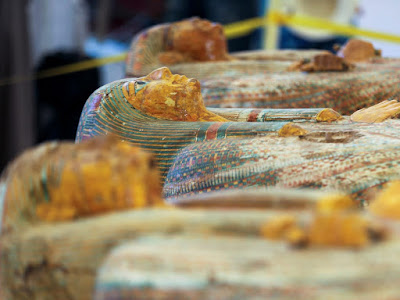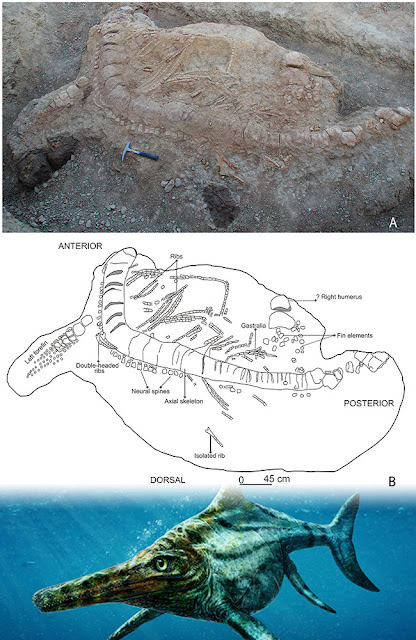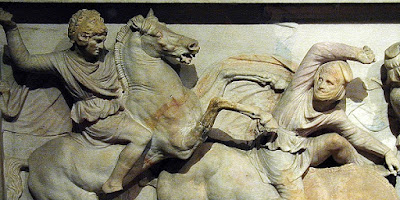 | Last year the bidding for the sixth known surviving piece from the John Bartlam factory in Cain Hoy, South Carolina opened at £10,000. It rose quickly in increments of £5000 up to £200,000. Then bids continued in increments of £10,000. |  The teapot was estimated at £10,000-20,000. It was found at a flea market. The teapot was estimated at £10,000-20,000. It was found at a flea market. |
Friday, October 25, 2019
£15 Early American teapot makes £460k
Sunday, October 20, 2019
20 ancient wooden coffins uncovered in Egypt - Update
 | Archaeologists have uncovered at least 20 ancient wooden coffins in the southern city of Luxor. The ministry says archaeologists found the coffins in the Asasif Necropolis. The necropolis is located in the ancient town of West Thebes and includes tombs dating back to the Middle, New Kingdom and the Late Periods (1994 B.C. to 332 B.C.). |
 | Researchers have cracked open the spectacular wooden coffins and have found perfectly preserved mummies. The find is being described as the most important in a century. The coffins are estimated to be 3,000 years old. |  |
 | The coffins were found sealed and intact, featuring vibrant color inscriptions and well-preserved engravings, both inside and out. Inscriptions suggest the coffins were for children and priests. |  |
Monday, October 14, 2019
The Hanksville-Burpee Quarry
 | Hanksville-Burpee Quarry is a paleontological excavation site near Hanksville, Utah where scientists have found a large mix of remains dating between 145 million years ago to 150 million years ago. The remains deposited in this one location provide a unique opportunity for scientists to study the late Jurassic period. |  |
 | The Hanksville dig site used to be an ancient river, and when dinosaurs would die the carcasses would be washed down the river and deposited along its banks. Now some 147 million years later scientists and volunteers from the Burpee Museum are unearthing them. |  |
 |   |
Saturday, October 12, 2019
Ichthyosaur fossil proves ancient sea monster roamed the world
 | Last year a nearly complete fossil of the giant ‘lizard fish’ Ichthyosaur was unearthed in India. It’s the first time the fishlike reptile has been found on the sub continent. It was found among the remains of its prey. It appears to belong to the Ophthalmosauridae family of Ichthyosaurs, closely related to Northern Hemisphere varieties. It likely lived between 152 and 157 million years ago. |
Friday, October 11, 2019
Vivid fresco depicting gladiators found in Pompeii
 | A vivid fresco depicting a gladiator standing victorious as his wounded opponent gushes blood has been discovered in the ancient Roman city of Pompeii. A 'murmillo' holds aloft his shield in his left hand, as he grips his short sword in the right. On the ground next to him lies the shield of the defeated 'thraex', who has suffered wounds and is bleeding. The thraex is gesturing with his hand, possibly asking for mercy.  |
Ancient gold coins
 | Example of the most successful coin in history; an antique fine gold ducat or Zecchino, minted under the 82nd Doge of Venice, Lorenzo Priuli. Struck 1556 - 1559 in Venice, Italy. The gold ducats of Venice were first struck in 1284. Their very high gold content (99.40%) made the coins extremely desirable and they are considered to be the earliest examples of a globally accepted currency. Ducats continued to be struck for over 500 years - longer than any other coin issue in history. $1,250.00 |  |
 | An ancient Indian gold Maiores Domus dinar from the Kushan Empire, struck under Emperor Vasudeva II circa 270 - 310 A.D. The obverse with Vasudeva II, nimbate, standing left, sacrificing over altar and holding filleted scepter; in left field, filleted trident. The reverse with the goddess Ardoxsho, seated facing on throne, holding diadem and cornucopia. $850.00 |  |
 | An ancient Greek hekte from Cyzicus, Mysia, struck circa 500 - 450 B.C. The obverse with naked youth kneeling right, hair bound by taenia with frontal projection, holding knife and tunny fish (emblem of Cyzicus). The reverse with quadripartite incuse square punch. Kyzikos was a wealthy ancient town located between the Aegean and the Black Sea, its advantageous position made it a major center for commerce and trade. $2,250.00 |  |
 | Ancient Celtic gold stater struck by the Chief of the Corieltauvi tribe, Volisios Dumnocoveros. Dating to the Late Iron Age circa 20 - 35 A.D. The obverse with a vertical wreath made up of square leaves running in opposite directions from the centre of the coin. Across this in two lines is the legend: VOLISIOS. The reverse with disjointed Celtic horse, galloping left. $3,250.00 |  < < |
 | An ancient Byzantine gold solidus of Emperor Basiliscus, (Flavius Basiliscus Augustus.) Struck January 475 - August 476 A.D. at the Constantinople mint. The obverse with a superb portrait of Basiliscus carrying a spear which rests over his shoulder and holding an oval shield, decorated with a horseman spearing a fallen enemy. The legend reading: D[ominvs] N[oster] BASILICVS P[ater] P[atriae] AVG[vstvs] "Our Lord Basiliscus, Father of the People, Augustus" |  The reverse with the goddess, Victory standing left holding a long, jewelled cross and wearing loose drapery. $7,000.00 The reverse with the goddess, Victory standing left holding a long, jewelled cross and wearing loose drapery. $7,000.00 |
Thursday, October 10, 2019
Largest Creatures to ever walk Earth
 | In 2016 paleontologists in Patagonia, southern Argentina announced they unearthed a 90-million year-old fossil of what they claim is the largest dinosaur found to date. The dinosaur weighed about 80 tons, the equivalent of 14 grown elephants. The new dinosaur dwarfs even the Argentinosaurus, the previous largest contender.  |
 | A complete skeleton was found in a field discovered by a farm worker in 2014, where up to seven such complete skeletons are believed to exist. |  |
 | The titanosaur lived during the Cretaceous and was a sauropod – a huge plant-eater. Vertebrae and rib bones were among the finds from the quarry at La Flecha ranch, Chubut Province in Argentina. |  |
 |
Meteorite smashed into Earth 12,800 years ago
 | Scientists in South Africa have discovered new evidence that the Earth was struck by a meteorite or asteroid 12,800 years ago, causing global climate change and mass extinction. Soil samples from an archaeological site called Wonderkrater outside a small town north of Pretoria found a spike in platinum levels, which they say supports the Younger Dryas Impact hypothesis. The theory assumes that a disintegrating asteroid, which is high in platinum, impacted Earth, causing an ice age. Many large species were wiped out as a result off the Earth’s rapid cooling. The impact from the asteroid or comet sent dust into the air, which might have reduced the amount of sunlight reaching Earth. |
Pollen from various plants also reveal a much cooler period, which is called the Younger Dryas. Scientists believe human populations may have also have been negatively affected. |  |
Wednesday, October 9, 2019
Alexander the Great's gold distater
 Athena was the protector of Hercules, and Alexander adopted her image on his gold coinage, showing her wearing a Corinthian helmet with a coiled snake. | Alexander the Great, born in 356 BC, was one of the most successful military leaders in history. He conquered a large part of Asia and ruled a kingdom that spanned from the Ionian sea to the Himalayas before he was 30 years old. One of his many achievements was a single currency across his empire. Flush with vast hoards of Persian gold he struck the largest Greek gold coin issued up to that time: the gold distater. Alexander the Great was determined to outdo the hero Hercules. |  |
 Sarcophagus of King Abdalonymos of Sidon | The reverse is represents Nike, the goddess of victory. Gold distaters were very valuable. This was inconvenient for daily use, so most were melted down. Staters weighed roughly 8.6g of .997 fine purity. Exceptional examples are always in high demand. Coins that were struck during his reign (lifetime issues) are the most desirable by collectors and the rarest. |  |
See ----->Top Macedonian Artifacts
Tuesday, October 8, 2019
Utah Dinosaur 'death trap' reveals tove of predators
| A nine-ton block of sandstone that was pulled from a Utah mountain in 2014 holds the biggest fossil trove ever found of the giant predatory dinosaur known as Utahraptor. Utahraptor was covered in feathers, with a huge sickle claw on each second toe. All the Utahraptor fossils are contained within a large block of sandstone that was once what geologists call a "dewatering feature," or quicksand. The Utahraptor was the largest of a group of lightly-built carnivores, called the dromaeosaurs ('swift lizards'). It had large eyes, long grasping hands and powerfully clawed feet. |  |
 | It was carnivorous and relied on a hooked, slashing claw on each foot rather than the jaws and teeth of a typical predator. Its toe joints were specially enlarged so that its massive claw could be raised upward and backward to avoid damage while running. |  The dromaeosaur group also included Velociraptor, made famous by Steven Spielberg in 'Jurassic Park'. |
 | By chipping off smaller pieces of the block, researchers uncovered bones from a 16-foot-long adult Utahraptor, four juveniles, and a baby that would have been only about three feet long. |
Other bones at the site belong to a beaked, bipedal herbivore called an iguanodont. The dinosaurs may have been what attracted the Utahraptor group to the site. |  |
Subscribe to:
Comments (Atom)



